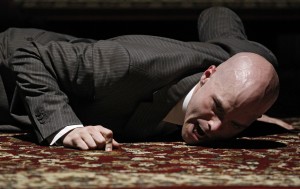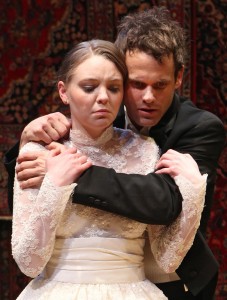The road to hell is paved with the best of intentions… Or the road to heaven is littered with landmines… Certainly, for the Weather Underground, the truth lies somewhere in between the fuzzy, yellow lines. home/sick by The Assembly, now playing at The Collapsable Hole in Williamsburg, examines that rugged terrain through their thought-provoking production. The audience walks into a converted industrial space greeted by a man in a black suit and sunglasses. He politely offers us a beer and a button that reads, “My brain is a bomb.” As we take our seats- on chairs or benches or pillows- the lights shift, whirling us deep into a subversive world of young American idealists fighting for what they believe is the equality of all mankind. They are angry. They are fearless. They are brilliant. And they believe pacifism is a dead-end road.
Jess Chayes’s direction is daring and engrossing. The lines between actor and audience, play and reality, right and wrong, become so blurred it is hard not to get caught up in the fervor and passion of these romantics- even if you whole-heartedly disagree with their actions. Chayes intricately blends movement, dance, lighting and sound to capture not only the counterculture of the 70s but also the complex struggles and political questions these very real people were grappling with.
The talented ensemble delivers their performances with such empathy and honesty it is hard not to feel moments of compassion for a group of people who just blew up a building or robbed a truck. One of the most powerful moments for me was watching Edward Bauer fight back this child-like vulnerability when called out in front of the collective for confiding secrets and intimacy in one member over the others. And the rest of the cast is equally terrific! Their connection with one another, both as actors and characters, is palpable and powerful.
The Assembly does an impeccable job of presenting a fair, honest, and unapologetic look at who these people really were. I never once felt like I was watching a political play, but rather an honest depiction of real lives asking big questions about the nature of humanity. This is a group of brilliant artists who will, without question, make their mark in the world of theater for a long time to come.
It is hard to really understand the nature of a revolution when one has never suffered from oppression. Sure, there are plenty of battles worth fighting in this country. There is an abundance of greed and destruction and corruption worth questioning every waking moment of our lives.
But how does one really ignite a revolution when drugs, sex, food, and entertainment are so plentiful? When one has never watched his family starve or had his house burned to ash by ruthless armies? When one’s freedom of expression- the very freedom that allows us to put on theater in such abundance- has never been censored? Not that these are the only roots for a revolution, per se, but it has often been the case throughout history that society as a whole must hit rock bottom, people must truly have nothing left to lose, before they are willing to sacrifice their existence and beliefs to rise up against their own country.
The Weather Underground, in their haze of drugs, sex, and egos, seems to lose sight of this reality. Fortunately, The Assembly has retained the insight to question their actions… and ours.










